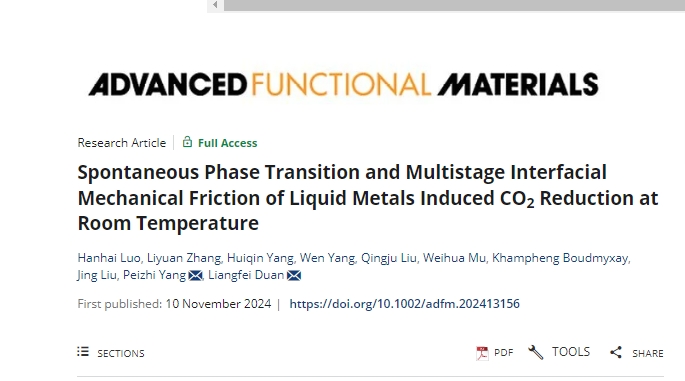博文
云师大能环学院杨培志教授、段良飞副教授课题组在《Advanced Functional Materials》发表最新成果
||
2024年11月10日,wiley旗下top期刊《Advanced Functional Materials》(影响因子:19.0)在线发表了云南师范大学能源与环境科学学院杨培志教授课题组与云南师范大学化学化工学院段良飞合作发表最新研究成果《Spontaneous Phase Transition and Multistage Interfacial Mechanical Friction of Liquid Metals Induced CO2 Reduction at Room Temperature》。云南师范大学能源与环境科学学院杨培志教授课题组与云南师范大学化学化工学院段良飞为共同通讯作者。
https://onlinelibrary.wiley.com/doi/10.1002/adfm.202413156

Abstract
Excessive emissions of carbon dioxide (CO2) have caused the greenhouse effect and environmental crisis. Therefore, the carbon reduction and negative carbon technologies are particularly important. Among these, the negative carbon technologies that convert CO2 into carbon materials or carbon-based chemicals for reuse have attracted significant attention. However, the strong double covalent bonds make the CO2 conversion usually require harsh conditions, complex processes, and high energy consumption. Gallium-based liquid metals (LMs) are the functional materials with both metallic and liquid properties, exhibiting a unique liquid-phase structure and diverse surface characteristics. Herein, a strategy for reducing CO2 is proposed to carbon materials by utilizing the spontaneous phase transition and mechanical friction of liquid metals. The gallium (Ga) and indium (In) particles are mixed and exposed to CO2, the contact interface of metal particles spontaneously transforms into liquid metals. The system has multistage interfaces, including Ga/In, Ga/eGaIn, and In/eGaIn, capable of generating triboelectrification upon mechanical stimulation, leading to charge transfer. The high electric field generated by friction at the contact interface directly reduces CO2 to carbon materials at room temperature. The carbon materials cover the surface of eGaIn and can be directly stripped for used as fuel, or industrial applications.

二氧化碳(CO2)的过量排放造成了温室效应和环境危机,因此碳减排和负碳技术尤为重要,其中将CO2转化为碳材料或碳基化学品再利用的负碳技术备受关注。然而,强双共价键使得CO2转化通常需要苛刻的条件、复杂的过程和高能耗。镓基液态金属(LMs)是一种兼具金属和液体特性的功能材料,具有独特的液相结构和多样的表面特性。该研究提出了一种利用液态金属的自发相变和机械摩擦将CO2还原为碳材料的策略。将镓(Ga)和铟(In)颗粒混合并暴露在CO2中,金属颗粒的接触界面自发转化为液态金属。该系统具有多级界面,包括Ga/In、Ga/eGaIn和In/eGaIn,能够在机械刺激下产生摩擦电,从而导致电荷转移。在室温下,接触界面摩擦产生的高电场直接将CO2还原为碳材料。碳材料覆盖在eGaIn表面,可以直接剥离用作燃料或工业应用。
https://mp.weixin.qq.com/s/4FGTifmuZdB_CzkhMrjBbA
扩展阅读:
云师大能环学院杨培志教授课题组在国际知名能源期刊《Nano Letters》发表最新研究成果
云师大能环学院杨培志教授、段良飞副教授课题组在国际知名能源期刊《Nano Energy》发表最新研究成果
云师大能环学院杨培志教授在top期刊《Rare Metals》上发表最新研究成果
云师大能环学院杨培志教授在top期刊《Carbon》上发表最新研究成果
云师大能环学院杨培志教授课题组在《Advanced Functional Materials》上发表最新研究成果
云师大能环学院杨培志教授课题组与山东科技大学段加龙和唐群委合作在《Carbon Energy》上发表最新研究成果
云师大杨培志教授课题组在top期刊《Chemical Engineering Journal》发表最新研究成果
云师大杨培志教授与中国海洋大学合作在《NANO ENERGY》上刊文
https://blog.sciencenet.cn/blog-454141-1460141.html
上一篇:云南师范大学2025年博士研究生招生章程 (第一批次)
下一篇:云师大信息学院户战选在国际权威期刊《Neural Networks》发表研究成果